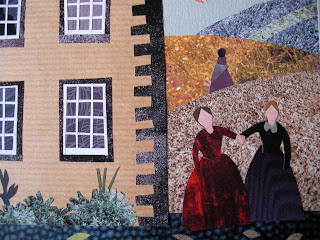 |
| Haworth Parsonage, Autumn Evening |
"My home is humble and unattractive to strangers, but to me it contains what I shall find nowhere else in the world - the profound, the intense affection which brothers and sisters feel for each other when their minds are cast in the same mould, their ideas from the same source - when they have clung to each other from childhood ...", said Charlotte Brontë in 1841
 |
| Detail showing the sisters |
And there they are again, inside the plain, solid, somewhat comfortless house (their father brooked no curtains or carpets for fear of fire, apparently) looking out of the windows.
I once read a Freudian interpretation of Wuthering Heights, the author of which had counted the number of times that windows and doors featured in the work. Having lived with the facade of Haworth Parsonage for a couple of weeks I have to say that windows were an architectural feature the Brontës must have had an awful lot of trouble ignoring in their day-to-day lives.
They certainly had me cursing with the fiddly panes.
Eight years after Charlotte Brontë wrote the lines quoted above, she was to write to her friend, wryly laughing off the suggestion she take a companion (her siblings having died in the intervening years):
"... the young person whom I might request to come and bury herself in the hills of Haworth - to take a church and stony churchyard for her prospect - the dead silence of a village parsonage - in which the tick of the clock is heard all day long - and a grave, silent spinster for her companion ..."
Needless to say she didn't wish the fate on anyone.
Now that does sound a grim and tragic scenario, but even that isn't as grim and tragic as the one which would be the lot of their father who outlived them all by six years,
I feel a bleaker parsonage picture coming on ....
very very good Amanda. And the background to it just adds so much. A seller I am sure!!
ReplyDeleteThanks Alan. Cutting up bits of magazine paper and seeing what emerges is still fascinating me I am in danger of forgetting where I put my paintbrushes...
ReplyDeleteAbsolutely wonderful! I'm amazed you can find all that texture and colour from magazine pictures. So clever! And I love all the story that goes with it. I think I need to read the book again.
ReplyDeleteHi Deb, glad you like it. You'd be amazed at what you can find in the most unlikely corners of the most unpromising fashion magazine.
ReplyDeleteBig pieces can be tricky. I used good old brown parcel paper for the house - it has the added bonus of thin lines to echo the parsonage's brick facade. I like the thrill of the chase going through my scraps stash to hit on the right texture! I know, I should get out more ...
Sounds like me going through my stash of fabric!
ReplyDeleteI love your work. It's beautiful and very unique!
ReplyDeleteThank you very much Judy. You've bucked me up when I'm on a downer!
ReplyDelete